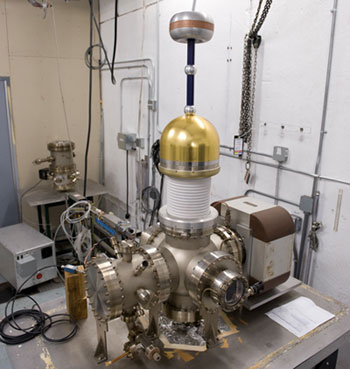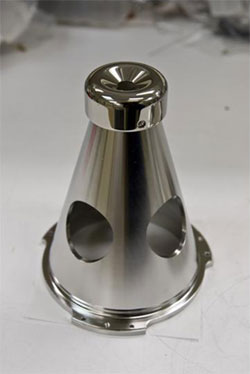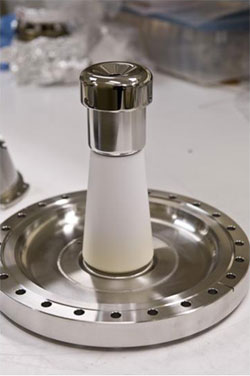
The cathode electrode is being put to the test in Jefferson Lab’s electron gun test stand. This work is part of a research project on the ILC's electron source, which is based in part on JLab’s CEBAF accelerator electron source research.
With the activation of the LHC, or Large Hadron Collider, some particle physicists are now looking forward to the next big machine. For many, that's the International Linear Collider. The ILC aims to break new ground in particle physics by slamming a beam of electrons into a beam of the electron's alter ego: the positron.
Half of the collider's beam is very familiar to the scientists and engineers at Jefferson Lab, who operate and continue to develop the technology that provides the lab's CEBAF accelerator with electrons. It only seems natural, then, that the ILC design team came to Jefferson Lab for assistance in developing its own electron source.
Ken Surles-Law, a long-time accelerator coordinator and a Ph.D. student at Hampton University, is leading the inquiry into the ILC's electron source, which is based in part on CEBAF's electron source design. He says a major challenge for the ILC is the large number of electrons within its beam and natural inclination of electrons to repel each other.
"Space charge is the thing to overcome. The way you overcome it is to get the beam to become relativistic, or moving at nearly the speed of light, as fast as possible. And when the beam becomes relativistic, the beam has enough energy to overcome the electrons' natural repulsion," he says.
Simply put, the ILC electrons need an initial jolt to propel them into the accelerator. To that end, Surles-Law and his colleagues are working to improve the cathode electrode, the metal device that houses the source of electrons. They are testing different cathode electrode processing techniques, materials and designs.
The cathode electrode contains the photocathode, a thin wafer of material composed of gallium-arsenide. The photocathode gives off electrons when struck by laser light. To get enough electrons out of the photocathode for the ILC, the cathode electrode housing will need to carry a very high bias voltage (potential difference), preferably much higher than the voltage used in CEBAF. CEBAF's electron gun uses a stainless steel cathode assembly that can operate reliably at 100kV, while the ILC baseline design calls for 140kV.

This is an older model of a Jefferson Lab cathode electrode.
But increasing the voltage on the cathode electrode could cause field emission, where electrons jump out of sharp, microscopic points on the cathode electrode and strike internal gun components and chamber walls. Field emission gets worse when voltage is increased and uncontrolled field emission from the cathode electrode can damage the exceptionally delicate photocathode, causing it to fail.
To prevent field emission, CEBAF cathode electrodes are painstakingly polished with diamond paste of finer and finer grit to manually remove any microscopic peaks in the metal, a process that can take weeks. However, measurements indicate that this polishing method will not work reliably at the higher voltages and gradients intended for the ILC.
In search of a better polishing method, Surles-Law turned to technology being used by JLab's SRF Institute to prepare accelerator cavities for testing. Electropolishing is used to clean accelerator cavities prior to performance tests. This technique uses acids activated by an electric current to chemically remove the outermost layer of metal to provide a smoother surface.
"What I'm looking at now is a stainless steel cathode electrode that has been polished by a diamond paste and comparing it to a stainless steel cathode electrode that has been electropolished. So far, our electropolished cathode electrodes emit less field emission than those that are diamond-paste polished," he says.
Another possible avenue for improving cathode electrode performance is changing the material used to make the cathode electrode. Surles-Law is testing whether a cathode electrode made from niobium will work.

Shown is the new high-voltage cathode electrode featuring the ceramic insulator.
Niobium is attractive, because it can be produced with a very smooth surface. It turns out that how the metal is produced can affect its smoothness – dictating whether or not it contains microscopic pits and points. The standard production process for aluminum, for instance, yields a metal with microscopic surface cracks. Polishing stainless steel renders a nearly smooth surface, but the boundaries between individual stainless steel molecules can not be perfectly smoothed through polishing, Surles-Law says.
The SRF Institute has found that these variations can be all but eliminated in niobium, the metal used in other accelerator components at Jefferson Lab. Unlike stainless steel, niobium is a naturally occurring metal that can be processed in such a way that the metal forms one, giant crystal. The resulting crystal has a smooth surface free of the cracks that could harbor impurities.
"So the next thing that we're going to look at is single-crystal niobium electrodes," Surles-Law explains.
Surles-Law is also testing a new style of ceramic insulator, a component that allows the cathode electrode to be biased at high voltage. Should the cathode electrode begin field-emitting electrons, the electrons could punch holes through the walls of the electron source's outer shell, exposing its delicate components.
"Present designs often vent to atmosphere when field emission is profound. Of course we don't want field emission, but if it's there, we don't want it to destroy the gun," Surles-Law says. "I'm going to measure field emission from this new configuration. And if the field emission is low, which we're hoping, then we're good. And we shouldn't have any field-emitted electrons punch through."
In addition, Surles-Law says that there are known issues with the cathode electrode design used in CEBAF and being considered for the ILC. Operational experience and computer models have revealed that as-is, the cathode electrode will cause distortion of the electron beam a few millimeters from the electrostatic center.
"The beam can become distorted to a point that we can't properly manage the beam. This problem will need to be solved for the ILC gun as well as the CEBAF gun," he says. While Surles-Law's research is ongoing, he expects to wrap it up in the next year.

